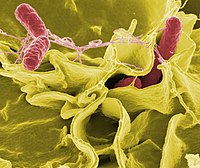
Photo from wikipedia
Salmonella enterica serovar Typhi (S. Typhi) is an essential enteric fever causing bacterium worldwide. Due to the emergence of multidrug-resistant strains, urgently attention is needed to prevent the global spread… Click to show full abstract
Salmonella enterica serovar Typhi (S. Typhi) is an essential enteric fever causing bacterium worldwide. Due to the emergence of multidrug-resistant strains, urgently attention is needed to prevent the global spread of them. Vaccination is an alternative approach to control these kinds of infections. Currently available commercial vaccines have significant limitations such as non-recommendation for children below six years of age and poor long-term efficacy. Thus, the development of a new vaccine overcoming these limitations is immediately required. Reverse Vaccinology (RV) is one of the most robust approaches for direct screening of genome sequence assemblies to identify new protein-based vaccines. The present study aimed to identify potential vaccine candidates against S. Typhi by using the RV approach. Immunogenicity of the best candidate against S. Typhi was further investigated. The proteome of S. Typhi strain Ty2 was analyzed to identify the most immunogenic, conserved, and protective surface proteins. Among the predicted vaccine candidates, steD (fimbrial subunit) was the best for qualifying all the applied criteria. The synthetic steD gene was expressed in E.coli, and the mice were immunized with purified recombinant steD protein and then challenged with a lethal dose of S. Typhi. Immunized animals generated high protein-specific antibody titers and demonstrated 70% survival following lethal dose challenge with S. Typhi. Pretreatment of the S. Typhi cells with immunized mice antisera significantly decreased their adhesion to Caco-2 cells. Altogether, steD as a protective antigen could induce a robust and long term and protective immunity in immunized mice against S. Typhi challenge.
Journal Title: Genomics
Year Published: 2020
Link to full text (if available)
Share on Social Media: Sign Up to like & get
recommendations!